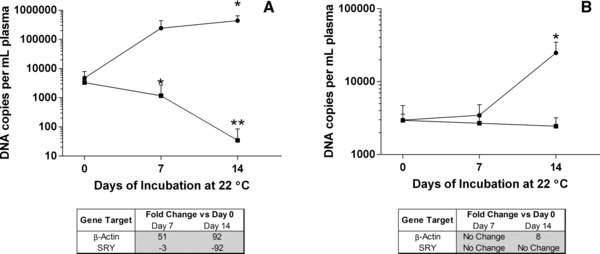Figure 2.

Effect of elevated background genomic DNA (gDNA) in plasma on the detection of rare DNA sequences. Blood was drawn from nonpregnant female donors into K 3 EDTA or BCT and stored at 22°C for 0, 7, or 14 days. At each time point, plasma was separated by centrifugation. A plasmid DNA construct containing a Y‐chromosomal sex‐determining region (SRY) sequence fragment (3,000 copies) was then spiked into all plasma samples and plasma DNA (pDNA) was extracted. Total pDNA concentration was determined using the β‐actin qPCR assay (●) and Y‐chromosomal sequence copy numbers were determined by the SRY qPCR assay (▪). For K 3 EDTA samples (Fig. 2A), as β‐actin pDNA concentrations increased in K 3 EDTA samples (*P < 0.05), there were statistically significant decreases in SRY sequence copy number detection (**P < 0.001). For BCT samples (Fig. 2B), pDNA concentrations remained close to the initial day 0 value (*P < 0.05) and the SRY sequence was detectible throughout the 14‐day time course. A table inset in each figure shows the fold change when comparing day 0 β‐actin and SRY levels to those on days 7 and 14. Error bars indicate SD, n = 5 for both panels.
